Abstract
The role of the human testis in the production of 17β-estradiol (E2) was investigated by determining the concentration of E2 and testosterone in peripheral and spermatic vein plasma samples. Specimens were obtained from eight normal men, three men with hypogonadism, and two patients with the incomplete form of the feminizing testes syndrome. For comparison, similar studies were performed in four monkeys, 10 mongrel dogs, and 4 additional dogs who were given 1000 IU of human chorionic gonadotropin/day for 5 days. Plasma E2 was measured by radioimmunoassay utilizing sheep anti-E2 serum preceded by ether extraction and thin layer chromatographic separation of plasma steroids. Procedural blanks, which were subtracted from all reported values were 14.1±0.74 (SEM) pg for deionized water and 13.1±0.66 pg for charcoaladsorbed pooled male plasma. Pooled male and pooled female control plasmas averaged 17±0.71 pg/ml and 95±6.9 pg/ml, respectively; individual adult male specimens ranged between 8 and 28 with a mean of 18±1.4 pg/ml. In the eight normal men, the mean peripheral vein E2 concentration was 20±1.6 pg/ml, while the spermatic vein concentration was 50 times as great, 1049±57 pg/ml. All three patients with testicular abnormalities had low spermatic vein E2 concentrations (160, 280, and 416 pg/ml). Lesser E2 gradients were found across the simian (3-fold) and canine (approximately 12-fold) testes. Testicular testosterone gradients (human 110-, simian 10-, and canine 77-fold) were greater than the E2 gradients in all three species. In four dogs, HCG treatment elicited a 6-fold increase in peripheral and a 9-fold increase in spermatic vein testosterone concentrations; however, peripheral and spermatic vein E2 concentrations did not differ from control values. Spermatic vein E2 concentrations were > 4600 and 2210 pg/ml (post-HCG) in two patients with the incomplete form of the feminizing testes syndrome. Postorchiectomy, peripheral E2 and testosterone concentrations fell precipitously in both patients, confirming the major contribution of the testes, in this syndrome, to circulating E2 and testosterone. These studies provide direct evidence that the human testic secretes estradiol.
Full text
PDF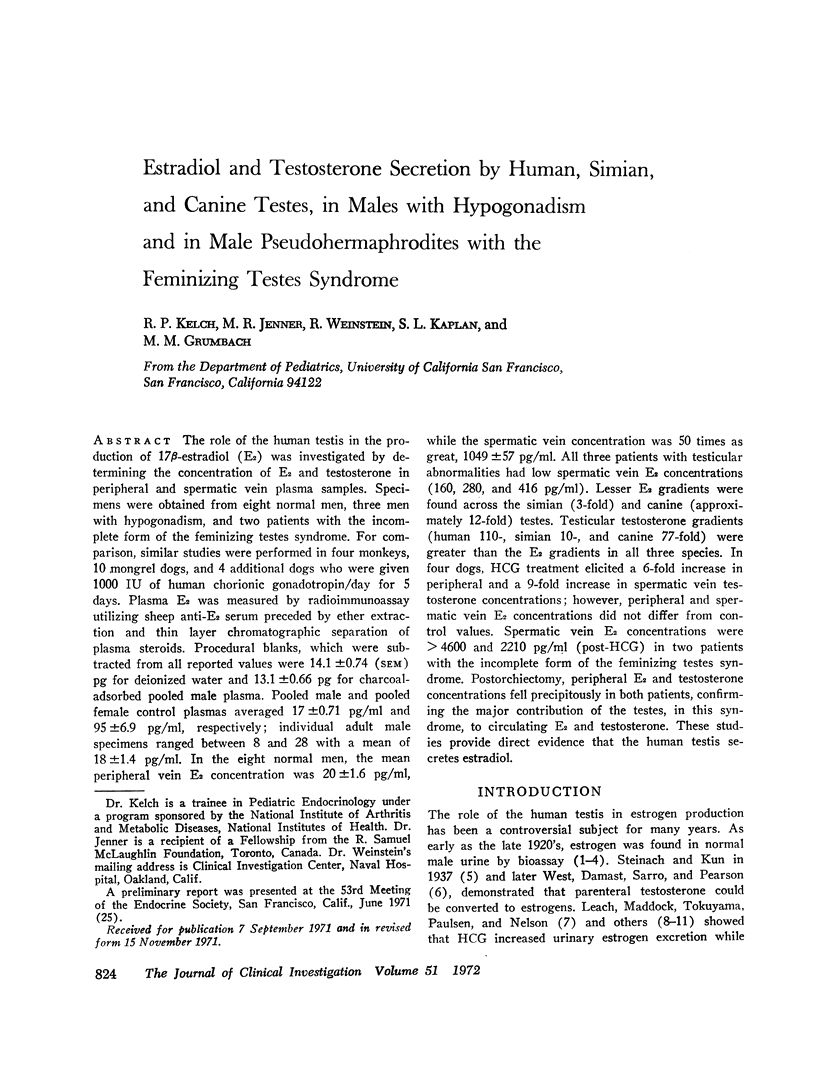
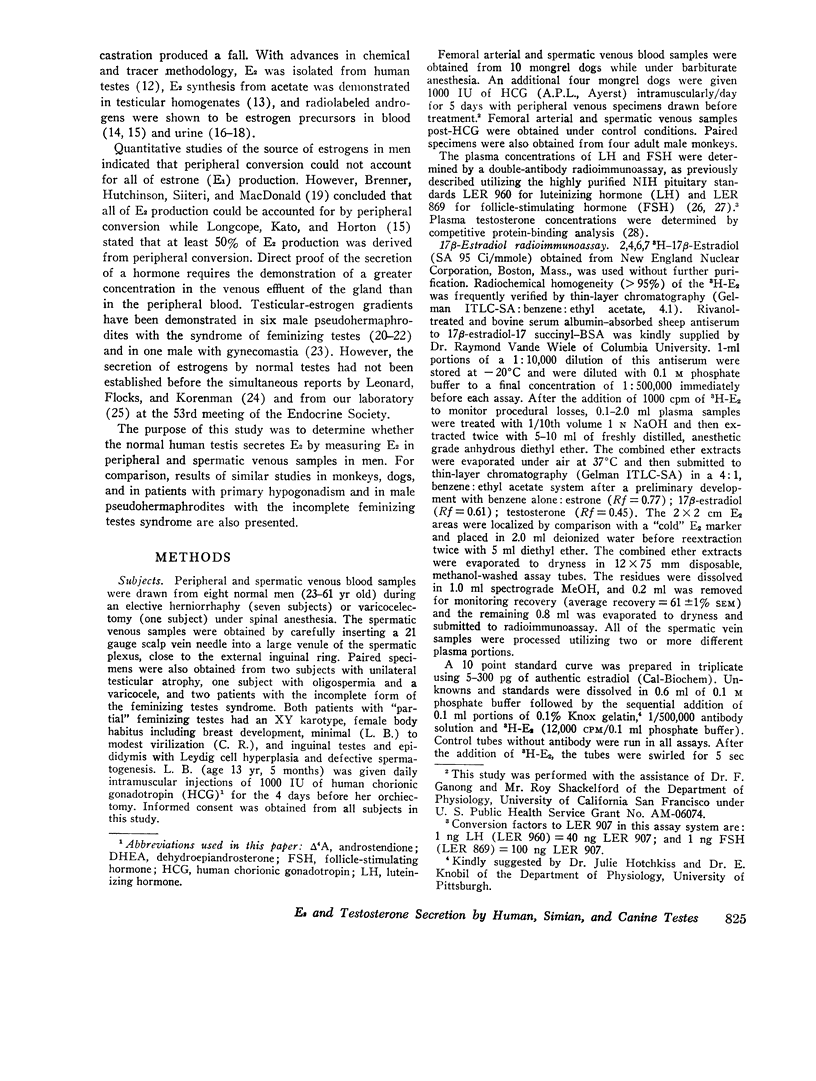
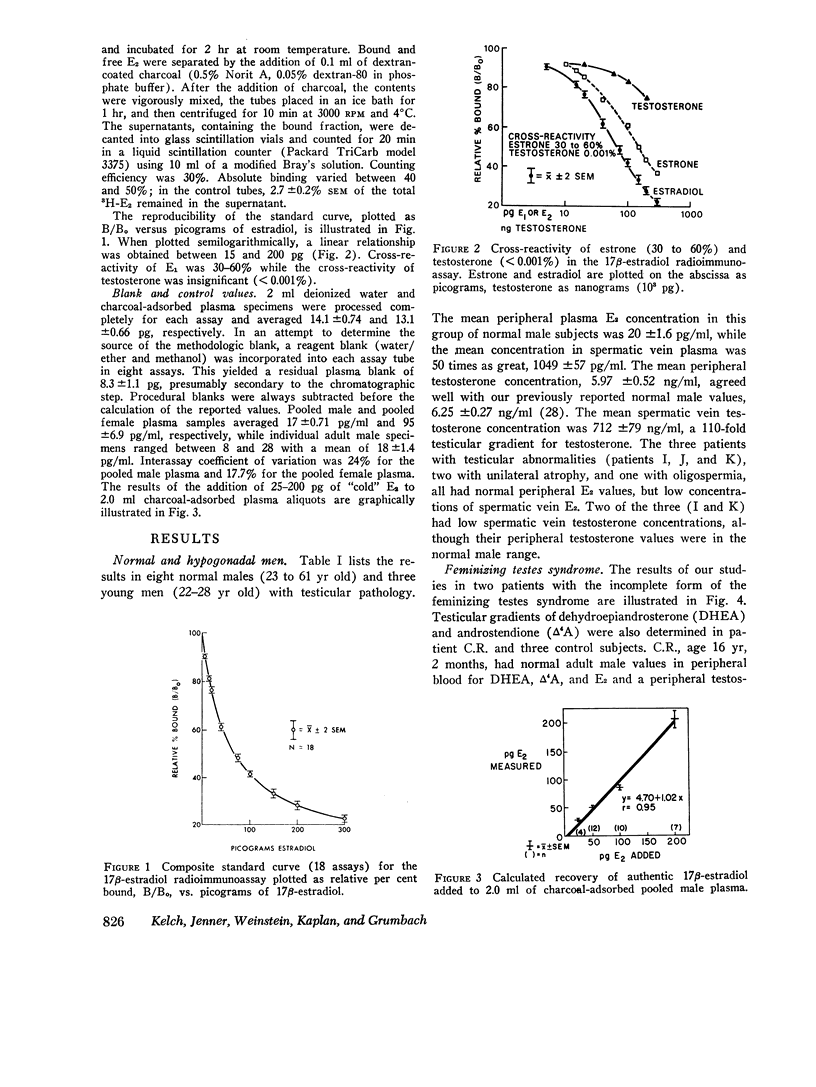

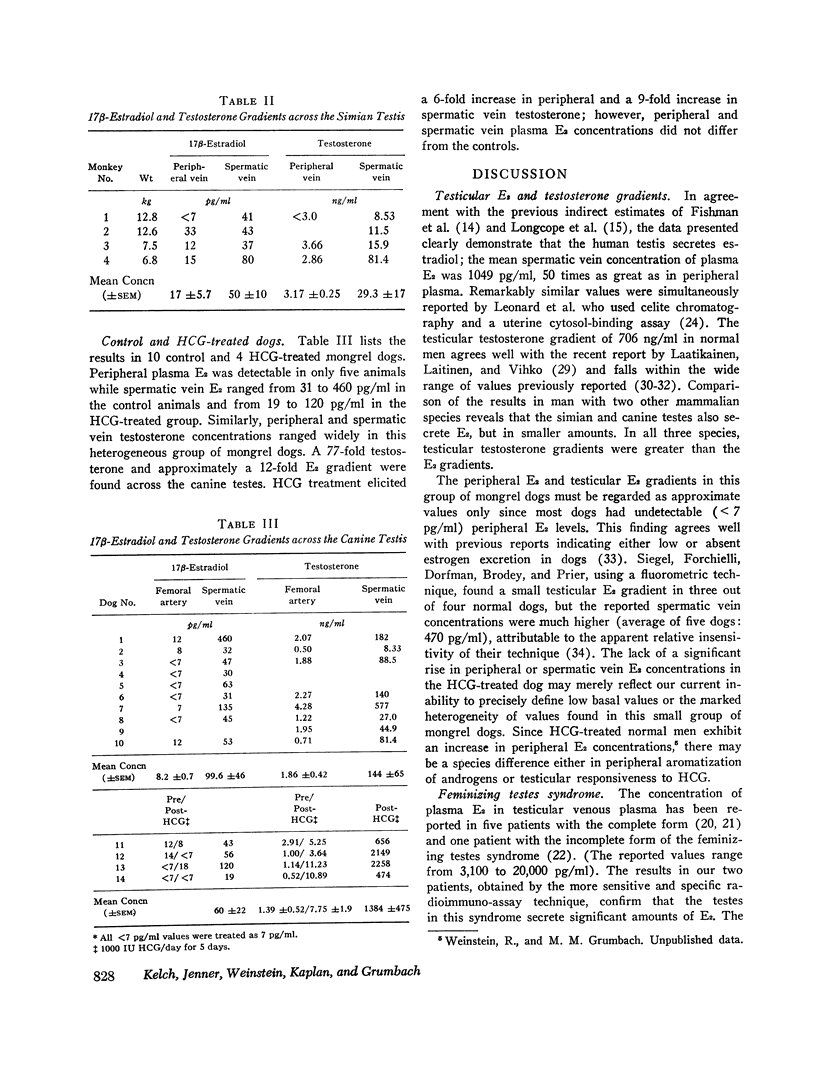
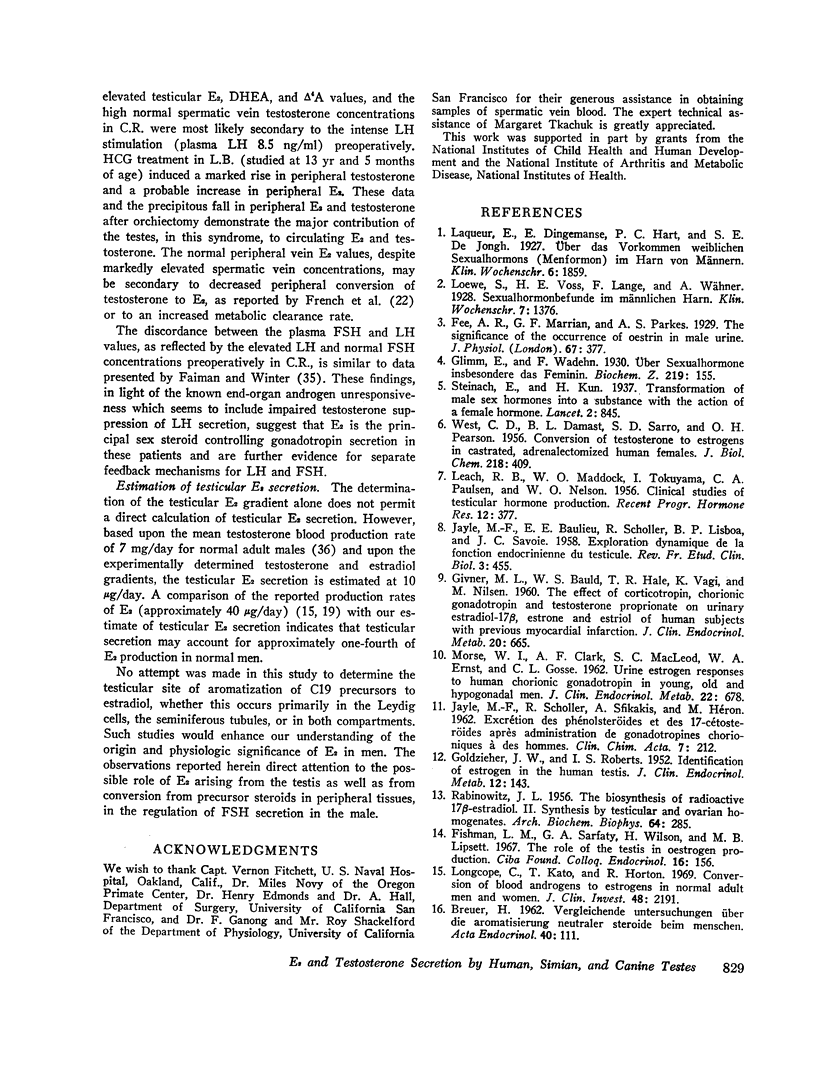
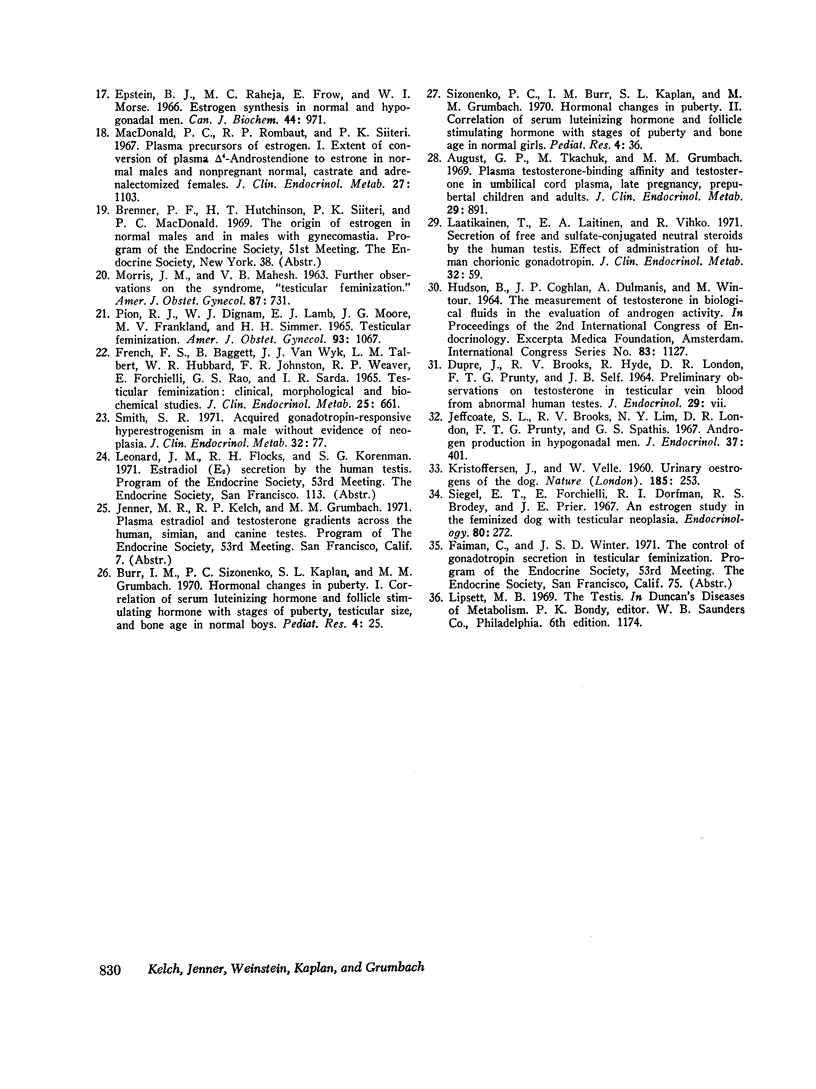
Selected References
These references are in PubMed. This may not be the complete list of references from this article.
- August G. P., Tkachuk M., Grumbach M. M. Plasma testosterone-binding affinity and testosterone in umbilical cord plasma, late pregnancy, prepubertal children, and adults. J Clin Endocrinol Metab. 1969 Jul;29(7):891–899. doi: 10.1210/jcem-29-7-891. [DOI] [PubMed] [Google Scholar]
- BREUER H. [Comparative studies on aromatic neutral steroids in man]. Acta Endocrinol (Copenh) 1962 May;40:111–122. [PubMed] [Google Scholar]
- Burr I. M., Sizonenko P. C., Kaplan S. L., Grumbach M. M. Hormonal changes in puberty. I. Correlation of serum luteinizing hormone and follicle stimulating hormone with stages of puberty, testicular size, and bone age in normal boys. Pediatr Res. 1970 Jan;4(1):25–35. doi: 10.1203/00006450-197001000-00003. [DOI] [PubMed] [Google Scholar]
- Epstein B. J., Raheja M. C., Frow E., Morse W. I. Estrogen synthesis in normal and hypogonadal men. Quantitative studies on the precursor role of testosterone. Can J Biochem. 1966 Jun;44(6):971–977. doi: 10.1139/o66-113. [DOI] [PubMed] [Google Scholar]
- FRENCH F. S., BAGGETT B., VANWYK J. J., TALBERT L. M., HUBBARD W. R., JOHNSTON F. R., WEAVER R. P., FORCHIELLI E., RAO G. S., SARDA I. R. TESTICULAR FEMINIZATION: CLINICAL, MORPHOLOGICAL AND BIOCHEMICAL STUDIES. J Clin Endocrinol Metab. 1965 May;25:661–677. doi: 10.1210/jcem-25-5-661. [DOI] [PubMed] [Google Scholar]
- Fee A. R., Marrian G. F., Parkes A. S. The significance of the occurrence of oestrin in male urine. J Physiol. 1929 Jul 25;67(4):377–382. doi: 10.1113/jphysiol.1929.sp002579. [DOI] [PMC free article] [PubMed] [Google Scholar]
- GIVNER M. L., BAULD W. S., HALE T. R., VAG I. K., NILSEN M. The effect of corticotropin, chorionic gondotropin and testosterone propionate on urinary estradiol-17 beta, estrone and estriol of human subjects with previous myocardial infarction. J Clin Endocrinol Metab. 1960 May;20:665–674. doi: 10.1210/jcem-20-5-665. [DOI] [PubMed] [Google Scholar]
- GOLDZIEHER J. W., ROBERTS I. S. Identification of estrogen in the human testis. J Clin Endocrinol Metab. 1952 Feb;12(2):143–150. doi: 10.1210/jcem-12-2-143. [DOI] [PubMed] [Google Scholar]
- JAYLE M. F., BAULIEU E. E., SCHOLLER R., LISBOA B. P., SAVOIE J. C. Exploration dynamique de la fonction endocrinienne du testicule. Rev Fr Etud Clin Biol. 1958 May;3(5):455–461. [PubMed] [Google Scholar]
- JAYLE M. F., SCHOLLER R., SFIKAKIS A., HERON M. [Excretion of phenol steroids and 17-ketosteroids after the administration of chorionic gonadotropins to men]. Clin Chim Acta. 1962 Mar;7:212–220. doi: 10.1016/0009-8981(62)90012-8. [DOI] [PubMed] [Google Scholar]
- Jeffcoate S. L., Brooks R. V., Lim N. Y., London D. R., Prunty F. T., Spathis G. S. Androgen production in hypogonadal men. J Endocrinol. 1967 Apr;37(4):401–411. doi: 10.1677/joe.0.0370401. [DOI] [PubMed] [Google Scholar]
- KRISTOFFERSEN J., VELLE W. Urinary oestrogens of the dog. Nature. 1960 Jan 23;185:253–254. doi: 10.1038/185253a0. [DOI] [PubMed] [Google Scholar]
- LEACH R. B., MADDOCK W. O., PAULSEN C. A., TOKUYAMA I. Clinical studies of testicular hormone production. Recent Prog Horm Res. 1956;12:377-98; discussion, 398-403. [PubMed] [Google Scholar]
- Laatikainen T., Laitinen E. A., Vihko R. Secretion of free and sulfate-conjugated neutral steroids by the human testis. Effect of administration of human chorionic gonadotropin. J Clin Endocrinol Metab. 1971 Jan;32(1):59–64. doi: 10.1210/jcem-32-1-59. [DOI] [PubMed] [Google Scholar]
- Longcope C., Kato T., Horton R. Conversion of blood androgens to estrogens in normal adult men and women. J Clin Invest. 1969 Dec;48(12):2191–2201. doi: 10.1172/JCI106185. [DOI] [PMC free article] [PubMed] [Google Scholar]
- MORRIS J. M., MAHESH V. B. FURTHER OBSERVATIONS ON THE SYNDROME, "TESTICULAR FEMINIZATION". Am J Obstet Gynecol. 1963 Nov 15;87:731–748. [PubMed] [Google Scholar]
- MORSE W. I., CLARK A. F., MacLEOD S. C., ERNST W. A., GOSSE C. L. Urine estrogen responses to human chorionic gonadotropin in young, old and hypogonadal men. J Clin Endocrinol Metab. 1962 Jul;22:678–682. doi: 10.1210/jcem-22-7-678. [DOI] [PubMed] [Google Scholar]
- MacDonald P. C., Rombaut R. P., Siiteri P. K. Plasma precursors of estrogen. I. Extent of conversion of plasma delta-4-androstenedione to estrone in normal males and nonpregnant normal, castrate and adrenalectomized females. J Clin Endocrinol Metab. 1967 Aug;27(8):1103–1111. doi: 10.1210/jcem-27-8-1103. [DOI] [PubMed] [Google Scholar]
- Pion R. J., Dignam W. J., Lamb E. J., Moore J. G., Frankland M. V., Simmer H. H. Testicular feminization. Am J Obstet Gynecol. 1965 Dec 15;93(8):1067–1075. doi: 10.1016/0002-9378(65)90174-2. [DOI] [PubMed] [Google Scholar]
- RABINOWITZ J. L. The biosynthesis of radioactive 17 beta-estradiol. II. Synthesis by testicular and ovarian homogenates. Arch Biochem Biophys. 1956 Oct;64(2):285–290. doi: 10.1016/0003-9861(56)90271-5. [DOI] [PubMed] [Google Scholar]
- Siegel E. T., Forchielli E., Dorfman R. I., Brodey R. S., Prier J. E. An estrogen study in the feminized dog with testicular neoplasia. Endocrinology. 1967 Feb;80(2):272–277. doi: 10.1210/endo-80-2-272. [DOI] [PubMed] [Google Scholar]
- Sizonenko P. C., Burr I. M., Kaplan S. L., Grumbach M. M. Hormonal changes in puberty. II. Correlation of serum luteinizing hormone and follicle stimulating hormone with stages of puberty and bone age in normal girls. Pediatr Res. 1970 Jan;4(1):36–45. doi: 10.1203/00006450-197001000-00004. [DOI] [PubMed] [Google Scholar]
- Smith S. R. Acquired hyperstrogenism of testicular origin without evidence of neoplasia. J Clin Endocrinol Metab. 1971 Jan;32(1):77–82. doi: 10.1210/jcem-32-1-77. [DOI] [PubMed] [Google Scholar]
- WEST C. D., DAMAST B. L., SARRO S. D., PEARSON O. H. Conversion of testosterone to estrogens in castrated, adrenalectomized human females. J Biol Chem. 1956 Jan;218(1):409–418. [PubMed] [Google Scholar]


